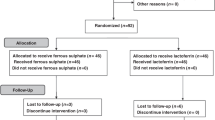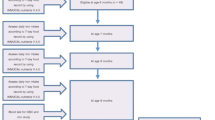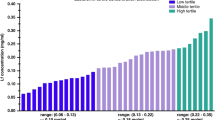Abstract
ABSTRACT: Iron absorption from human milk and infant formula has received much attention, but experimental design problems have been common. In our study, iron retention from human milk, milk-based infant formula (IF) with and without supplemental ferrous sulfate, and IF supplemented with either human or bovine lactoferrin (Lf) was evaluated in infant rhesus monkeys. The exchange of 59Fe (III) Cl3 between the whey, casein, and fat fractions required up to 72 h to reach the same distribution as intrinsic iron, depending on the type of diet. Infant monkeys were intubated with labeled human milk or IF and counted in a whole body counter. Each infant received all five diets and was also intubated with a reference dose of 55Fe (II) ascorbate. There was no significant difference in iron retention (mean ± SEM) from the experimental diets: human milk 32.5 ± 5.1%; IF 32.1 ± 8.0%; IF + Fe 23.0 ± 3.9%; IF + human Lf 23.5 ± 3.3%; IF + bovine Lf 22.7 ± 4.9%. Therefore, infant monkeys absorb and retain iron similarly from human milk and infant formula. Supplementation of infant formula with human or bovine Lf resulted in similar iron retention to that of ferrous sulfate-supplemented infant formula.
Similar content being viewed by others

Log in or create a free account to read this content
Gain free access to this article, as well as selected content from this journal and more on nature.com
or
Author information
Authors and Affiliations
Rights and permissions
About this article
Cite this article
Davidson, L., Litov, R. & Lönnerdal, B. Iron Retention from Lactoferrin-Supplemented Formulas in Infant Rhesus Monkeys. Pediatr Res 27, 176–180 (1990). https://doi.org/10.1203/00006450-199002000-00018
Received:
Accepted:
Issue date:
DOI: https://doi.org/10.1203/00006450-199002000-00018


